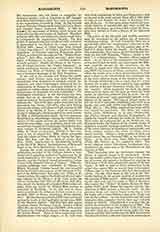

Mantegna, ANDREA, Italian painter; b. according to some authorities, at Vicenza, according to others at Padua, in 1431; d. at Mantua, September 13, 1506. Little is known of his origin save that he came of honorable parentage and was adopted at an early age by Francesco Squarcione who reared him as his son. Everything tends to show that his artistic education began very early, for he was at work upon masterpieces at an age when most artists are still under tuition. He owed little of what he knew to his foster-father, who, although the founder of the Paduan school of painting, possessed but mediocre ability. Mantegna’s earliest known work, a “Madonna in Glory“, was painted when he was seventeen for the church of S. Sofia at Padua. This picture is no longer in existence, but to judge from his next dated work, a fresco (1452) in the church of the Santo, Padua, this first achievement must have exhibited almost incredible maturity of talent. In 1454 he was employed in the church of S. Giustina, Padua, where he painted the Ancona, which is now in the Brera, at Milan. Squarcione had been commissioned by the Ovetari family to decorate the Church of the Eremitani, Padua, and he had deputed a portion of the task to Mantegna. By these frescoes, which attest a steady development, in his manner, he is doubtless best known. The probable dates are 1448-55 and the frescoes due to him are: on the left wall, “Baptism of Hermogenes”, “St. James before Caesar”, “St. James led to execution”, and “The Martyrdom of St. James”; on the right wall, “The Martyrdom of St. Christopher”, and “The Removal of his Body”. These works established his fame as the foremost painter of the Paduai school, and among those who recognized and applauded his genius was Jacopo Bellini, whose daughter; Nicolosia, Mantegna married in 1454. This brought about a rupture with Squarcione which was final.
At the height of his fame he painted the portrait of Cardinal Scarampi (1459), the altar-piece of the Church of San Zeno, Venice, and the “Agony in the Garden”. In 1457 Lodovico Gonzaga, Marquess of Mantua, invited Mantegna to enter his service, but it was two years before the successful artist could be persuaded to accept. In 1459 he went to Mantua, and here, save for the interval of his stay in Rome, whither he went at the request of Innocent VIII to decorate the new chapel in the Vatican, he spent the remainder of his life. He was held in great honor but treated with only spasmodic liberality, his salary being irregularly paid. Lodovico was succeeded in 1478 by his son Federigo, who died in 1484, and Francesco Gonzaga succeeded him at the age of eighteen. Francesco was betrothed to the beautiful and accomplished Isabella d’Este, one of the women whose appreciation and encouragement of art and letters did so much to make the Renaissance what it was. In 1485 Mantegna was ordered by Gonzaga to paint a Madonna for Isabella’s mother, the Duchess of Ferrara, to do which he interrupted a series of paintings, “The Triumph of Caesar”, now at Hampton Court, which he had begun soon after his arrival in Mantua. His work in the Vatican was another interruption, but on his return to Mantua in 1490 he continued this, the greatest of his works, which was completed in 1494.
In 1495 he painted an altar-piece in commemoration of the marquess’s victory at Fornovo. This picture, the “Madonna della Vittoria”, is now at the Louvre. The “Madonna and Saints”, painted for the church of Santa Maria in Organo, Verona, was finished in 1497. Another series of paintings was that executed for the Marchioness Isabella as decorations for her study. These were “The Triumph of Wisdom”, “Parnassus“, and “The Masque of Comus”, the last-named being finished by Lorenzo Costa. To the last period of his life belong the “Madonna and Saints”, now in the National Gallery, the “Dead Christ”, in the Brera, Milan, and “The Triumph of Scipio”, in the National Gallery. Mantegna’s work is grandly conceived and severely beautiful. His manner has been called dry and hard, but he exhibits marvellous art in his modeling of form and disposing of drapery, as well as great knowledge of design. He was one of the earliest Italian engravers on copper, but few of the plates attributed to him are his.
B. M. KELLY

